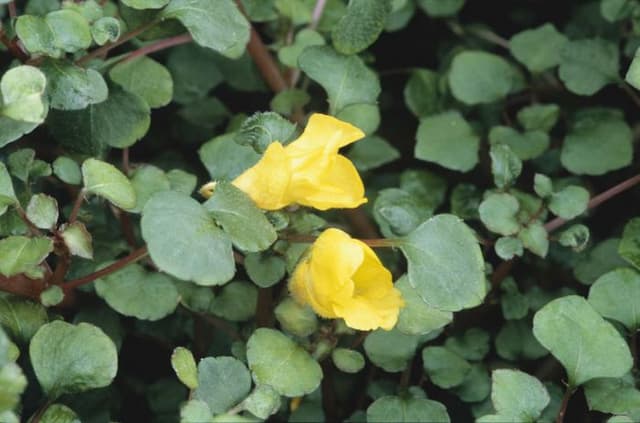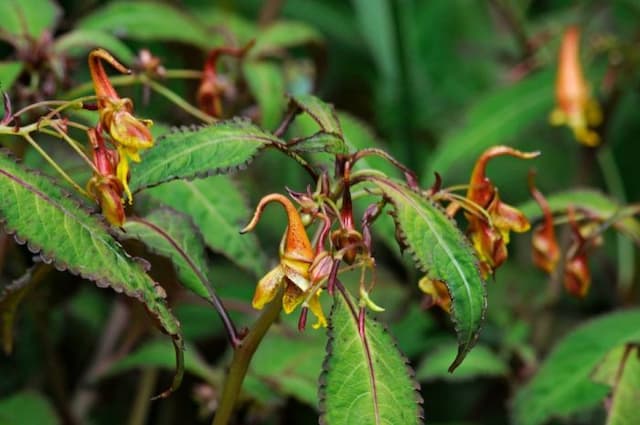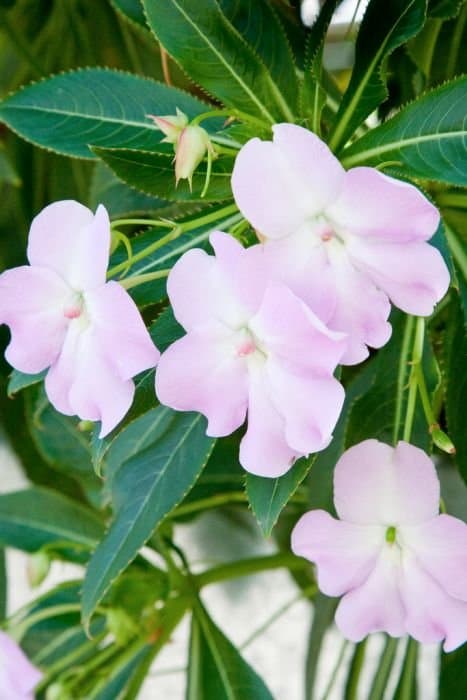Impatiens Impatiens Fanfare Fuschia = 'Balfafusia' (Fanfare Series)
![busy lizzie [Fanfare Fuschia]](/_next/image?url=https%3A%2F%2Fplants-admin.emdemapps.com%2Fimages%2Fplants%2F%2Fimages%2F604b552c08c40.png&w=3840&q=75)
ABOUT
The Impatiens Fanfare Fuschia, part of the Fanfare Series, is a vibrant and eye-catching flowering plant notable for its lush, bright fuchsia blooms. The flowers are characterized by a distinctive form, strikingly similar to a miniature trumpet, which gives the plant a festive and lively appearance. Each bloom is held aloft on sturdy stems that rise from a dense, green foliage. The leaves are usually medium green in color and have a glossy texture, which contrasts beautifully with the vivid flowers. The overall impression of the Impatiens Fanfare Fuschia is one of a cheerful and robust flowering plant that adds a pop of intense color to any garden or container display where it is grown. Its continuous display of flowers throughout the growing season makes it a favorite among gardeners looking to maintain a consistent and dynamic presentation of hues in their outdoor spaces.
About this plant
 Names
NamesFamily
Balsaminaceae
Synonyms
Fanfare Fuchsia Impatiens, Fuchsia Impatiens, Balfafusia Impatiens
Common names
Impatiens 'Balfafusia'
 Toxicity
ToxicityTo humans
Impatiens are not considered toxic to humans. If accidentally ingested, they are unlikely to cause poisoning or serious side effects. However, it is always recommended to discourage eating ornamental plants and to keep them out of reach of young children who might be tempted to taste them.
To pets
Impatiens, commonly known as Busy Lizzie, are generally considered non-toxic to pets, including cats and dogs. They are not known to cause poisoning if ingested. However, it's always a good practice to prevent pets from eating plants as a precautionary measure, and because individual animals might have different sensitivities or allergic reactions.
 Characteristics
CharacteristicsLife cycle
Annuals
Foliage type
Deciduous
Color of leaves
Green
Flower color
Fuschia
Height
1-2 feet (30-60 cm)
Spread
1-2 feet (30-60 cm)
Plant type
Herb
Hardiness zones
10
Native area
East Africa
Benefits
 General Benefits
General Benefits- Easy to Grow: This variety of impatiens is known for being particularly robust and easy to cultivate, making it a good choice for both beginner and experienced gardeners.
- Vibrant Colors: It produces vibrant fuchsia flowers that can brighten up any garden space, container, or hanging basket.
- Continuous Blooming: Impatiens provide continuous blooms from spring to the first frost, offering long-lasting visual interest in the garden.
- Shade Tolerant: The plant thrives in shady conditions where many other flowering plants may not perform as well, making it ideal for shaded gardens.
- Low Maintenance: Impatiens generally require minimal care apart from regular watering and occasional fertilization, making them a low-maintenance option for busy gardeners.
- Attracts Pollinators: While it is not their primary attribute, impatiens can attract pollinators such as butterflies, contributing to the biodiversity of the garden ecosystem.
- Versatile Use: They can be used in a variety of garden designs, including borders, mass plantings, and as companion plants in mixed containers.
- Fast Growing: Impatiens grow fairly quickly, filling in garden spaces and providing a lush appearance in a short period of time.
- Disease Resistance: The Fanfare Series, including Fanfare Fuschia, often exhibit resistance to common diseases that affect impatiens, ensuring a healthier garden.
 Medical Properties
Medical PropertiesThis plant is not used for medical purposes.
 Air-purifying Qualities
Air-purifying QualitiesThis plant is not specifically known for air purifying qualities.
 Other Uses
Other Uses- Artistic inspiration: Impatiens can serve as vibrant subjects in paintings, photographs, and other art forms due to their striking colors and shapes.
- Livestock feed: In certain cultures, the leaves of Impatiens may be fed to livestock in small quantities as a supplement to their diet.
- Educational tools: Impatiens are often used in schools for teaching botany and horticulture due to their rapid growth and easy care.
- Hummingbird attractant: Impatiens can attract hummingbirds to a garden, which in turn aids in the pollination of other plants.
- Craft materials: The colorful flowers and leaves of Impatiens can be used in crafting, such as making natural dyes for fabrics or pressed flower art.
- Companion planting: Impatiens are sometimes grown alongside vegetables as they can attract beneficial insects that prey on common garden pests.
- Children's gardens: Impatiens are ideal for children's gardens due to their non-toxic nature and fast-growing, colorful blooms that can engage young horticulturists.
- Cultural festivals: In some regions, Impatiens may be used during festivals or religious ceremonies to decorate homes, temples, or public spaces.
- Mood enhancement: Due to their vibrant appearance, Impatiens are believed to have a positive effect on mental well-being by uplifting moods when grown indoors or within a garden setting.
- Garden borders: Impatiens are commonly used to create colorful borders in gardens due to their uniform growth and vibrant flowers which can define the edges of garden beds or walkways.
Interesting Facts
 Feng Shui
Feng ShuiImpatiens are not specifically referenced in Feng Shui practice.
 Zodiac Sign Compitability
Zodiac Sign CompitabilityImpatiens are not used in astrology practice.
 Plant Symbolism
Plant Symbolism- Patience: Impatiens, as the name suggests, symbolizes the need for patience and the ability to bide one's time without becoming frustrated.
- Enduring Love: The persistent blooming of impatiens can be interpreted as a symbol of lasting affection and steadfastness in relationships.
- Motherly Love: Often given to mothers, impatiens may represent a gentle, nurturing love as seen in mother-child relationships.
- Personal Strength: The resilient nature of impatiens can reflect an individual's inner strength and ability to cope with adversity.
 Water
WaterThe Impatiens, commonly known as Busy Lizzie, requires consistent moisture and should be watered regularly, but overwatering must be avoided to prevent root rot. Water Busy Lizzies early in the morning to allow foliage to dry out during the day, reducing the risk of fungal diseases. The plant should be watered when the top inch of soil feels dry to the touch, which may translate to watering once every 2 to 3 days during hot, dry periods. Provide enough water to soak the root zone, typically about 16 ounces per plant, ensuring you water at the base and not over the foliage. During cooler or rainy periods, reduce frequency to when necessary, ensuring the soil does not become waterlogged.
 Light
LightBusy Lizzies thrive best in bright, indirect light or partial shade to protect their leaves and flowers from intense sunlight. They should be placed in a location where they can receive morning sunlight and afternoon shade or dappled sunlight throughout the day. Avoid placing them in full sun, especially during the hotter parts of the day, to prevent scorching.
 Temperature
TemperatureBusy Lizzies prefer warmer temperatures and thrive in conditions ranging from 60 to 75 degrees Fahrenheit. They can tolerate minimum temperatures of about 50 degrees Fahrenheit, but prolonged exposure to cold can damage the plant. Ideally, maintain a consistent and warm environment without sudden temperature fluctuations to keep the plant healthy.
 Pruning
PruningPruning Busy Lizzies promotes bushier growth and prevents legginess. Pinch back the tips of new growth every few weeks during the growing season to encourage a fuller plant. The best time for pruning is in the spring or early summer, before the flowering season peaks. Remove any dead or yellowing leaves and spent flowers regularly to maintain the plant's appearance and encourage further blooming.
 Cleaning
CleaningAs needed
 Soil
SoilImpatiens, also known by names such as Impatiens Fanfare or Balfafusia, thrive in moist, well-draining soil with a slightly acidic to neutral pH of 6.0 to 7.0. A mix of peat moss, perlite, and potting soil or a high-quality commercial potting mix is ideal, ensuring good aeration and moisture retention for healthy growth.
 Repotting
RepottingImpatiens, also known as Busy Lizzie, should be repotted annually in the spring to replenish nutrients and accommodate growth. They benefit from being placed in slightly larger pots each year to ensure they have enough room to expand.
 Humidity & Misting
Humidity & MistingImpatiens, commonly called Busy Lizzies, prefer high humidity environments, ideally between 50-70%. They thrive in a more humid atmosphere which can often be provided by grouping plants together or using a humidifier.
 Suitable locations
Suitable locationsIndoor
For Busy Lizzies, ensure bright, indirect light and maintain high humidity indoors.
Outdoor
Plant Busy Lizzies in partial shade and keep soil consistently moist.
Hardiness zone
10-11 USDA
 Life cycle
Life cycleImpatiens 'Balfafusia' begins its cycle with seed germination, occurring when conditions are warm and moist. Seedlings emerge and grow rapidly, thanks to the plant’s preference for rich, well-drained soil and partial to full shade conditions. The vegetative stage is characterized by the formation of glossy leaves and stems that can trail or spread depending on the support available. As it matures, the plant enters the flowering stage, producing vibrant fuchsia flowers that can bloom from late spring until the first frost. After pollination, seeds develop within capsules that burst open when ripe, distributing seeds for the next generation. In cold climates, the plant behaves as an annual, dying with the onset of winter, but in warmer areas or under protection, it may survive to produce new growth the following season.
 Propogation
PropogationPropogation time
Spring-Summer
Propogation: The Impatiens Fanfare Fuschia, part of the Fanfare Series and scientifically known as 'Balfafusia', is most commonly propagated through stem cuttings. The ideal time for taking stem cuttings is during late spring or early summer when the plant is actively growing. To propagate, a healthy stem with a few leaves is cut just below a node, usually about 2 to 3 inches (5 to 7.5 centimeters) long. The bottom leaves are removed, and the cut end is dipped in rooting hormone powder to encourage root development. The prepared cutting is then inserted into a pot filled with a well-draining potting mix, ensuring at least one node is buried where roots can emerge. The soil is kept moist and the pot is placed in a warm location with indirect sunlight until the cutting establishes a root system, which typically takes a few weeks. After rooting, the new plant can be treated as a mature Impatiens Fanfare Fuschia.
![Busy lizzie [SunPatiens Compact White Improved]](/_next/image?url=https%3A%2F%2Fplants-admin.emdemapps.com%2Fimages%2Fplants%2F%2Fimages%2F604b5dbdde5cf.png&w=640&q=75)
![Busy lizzie [SunPatiens Spreading Variegated Salmon]](/_next/image?url=https%3A%2F%2Fplants-admin.emdemapps.com%2Fimages%2Fplants%2F%2Fimages%2F604b5caea5496.png&w=640&q=75)
![Busy lizzie [Sun Harmony Deep Orange]](/_next/image?url=https%3A%2F%2Fplants-admin.emdemapps.com%2Fimages%2Fplants%2F%2Fimages%2F604b57b5f28cb.png&w=640&q=75)
![Busy lizzie [SunPatiens Compact Blush Pink]](/_next/image?url=https%3A%2F%2Fplants-admin.emdemapps.com%2Fimages%2Fplants%2F%2Fimages%2F604b64a6f0b6f.png&w=640&q=75)
![Busy lizzie [Divine Violet]](/_next/image?url=https%3A%2F%2Fplants-admin.emdemapps.com%2Fimages%2Fplants%2F%2Fimages%2F604b651b90e59.png&w=640&q=75)




![Busy lizzie [SunPatiens Compact Orange]](/_next/image?url=https%3A%2F%2Fplants-admin.emdemapps.com%2Fimages%2Fplants%2F%2Fimages%2F604b5ef883e70.png&w=640&q=75)